Taken in 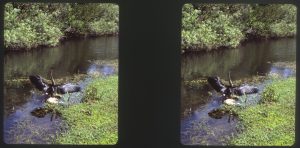 the Shark Valley unit of Everglades National Park, April 2016.
the Shark Valley unit of Everglades National Park, April 2016.
TL-120, Provia 100, exposure unrecorded.
Taken in  the Shark Valley unit of Everglades National Park, April 2016.
the Shark Valley unit of Everglades National Park, April 2016.
TL-120, Provia 100, exposure unrecorded.
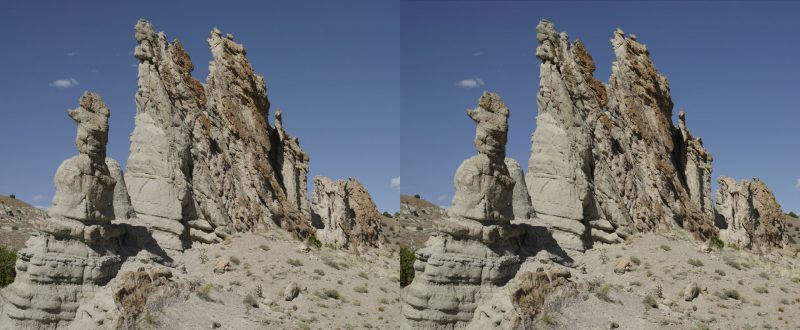
Plaza Blanca is about one hour north of Santa Fe New Mexico by car, the last couple of miles is a dirt road. Spectacular rock formations can be found only a few hundred yards from the parking lot. I’d just started walking again after all the foot surgeries. This was taken with a paired Merrill Dp2 rig, on a sliding bar with about 8 inch stereo base. Then the image was transferred to Provia 100F by photographing a 4K screen. (I describe the process in more detail in A28 folio notes). The developer was nearly exhausted and resulted in thick image with excessive contrast. I plan to send my film to Colorado lab in the future. There are lots of lovely digital images taken with this Foveon sensor camera (thanks to Boris Starosta for turning me on to the Merrill, he uses Merrills in his clear building series). The Foveon sensor records all RGB at each site in a ‘stack’ of sensors, so each color plane has all the full resolution, without interpolation since there is no Bayer filter. I plan to upgrade to a 10 bit calibrated 4K screen, and eventually to an 8K screen for future digital to film experiments. I’ll also do some head-to-head tests going back to photograph the original subjects with digital and film (TL-120 and paired Mamiya 220 85 and 55 mm). I’m quite please with the Merrill sensor and lens, have the DP3 now too. Merrills are like using slower film cameras (usually want ASA at 100, tripod or good light for routine use), the slowness comes from the ‘thickness’ of the sensor, as light has to make it into the depths of the chip to provide the color information. But this lens is amazingly sharp.
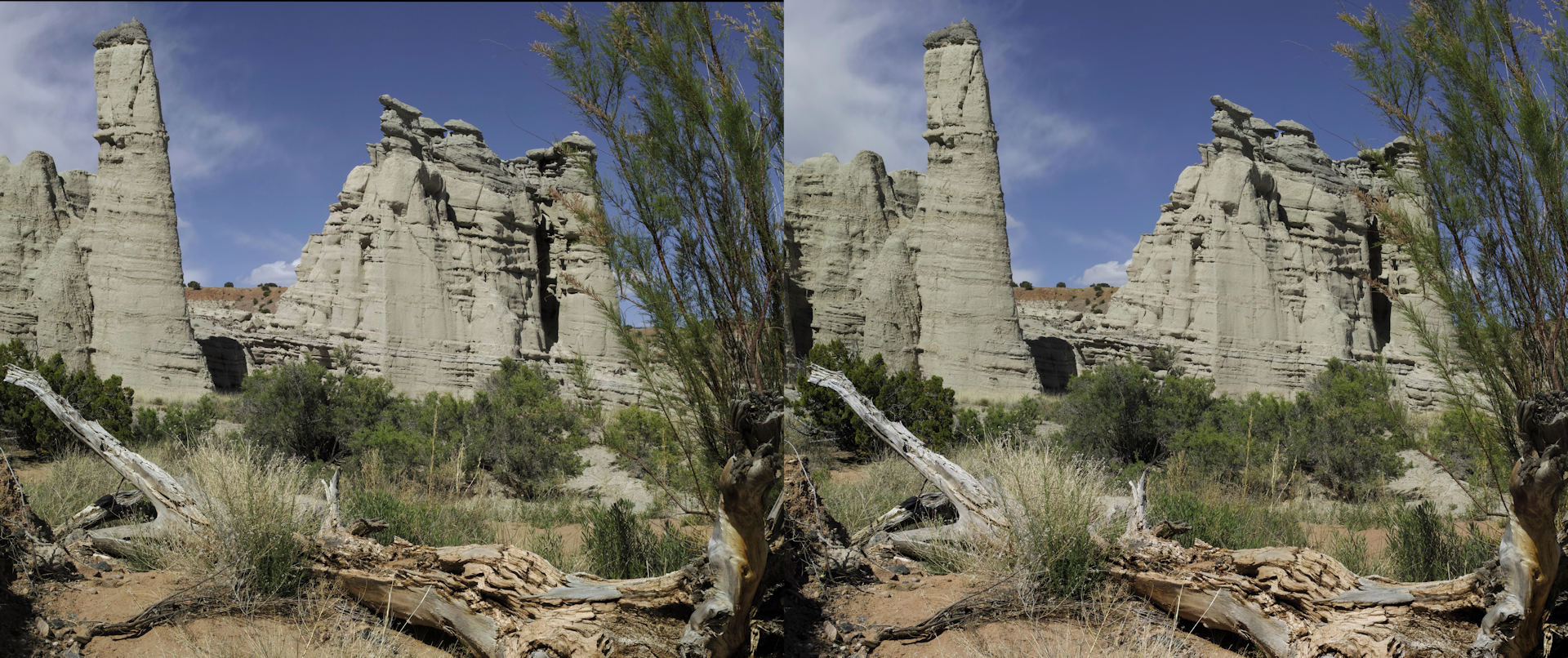
The Pillars, Plaza Blanca
Plaza Blanca is about one hour north of Santa Fe New Mexico by car, the last couple of miles is a dirt road. Spectacular rock formations can be found only a few hundred yards from the parking lot. The process used was the same as described for my image “Dragon Spine, Plaza Blanca”. This is one of the most beautiful sites in New Mexico for these odd eroded columns. These are a bit like the Tent Rocks (those are found an hour south of Santa Fe)…featuring a capstone protecting a column of softer material. Once the capstone is gone, the column will erode much faster. The area has changed in 10 years due to this process. If we ever have an NSA meeting in Santa Fe, this is one place to check out.
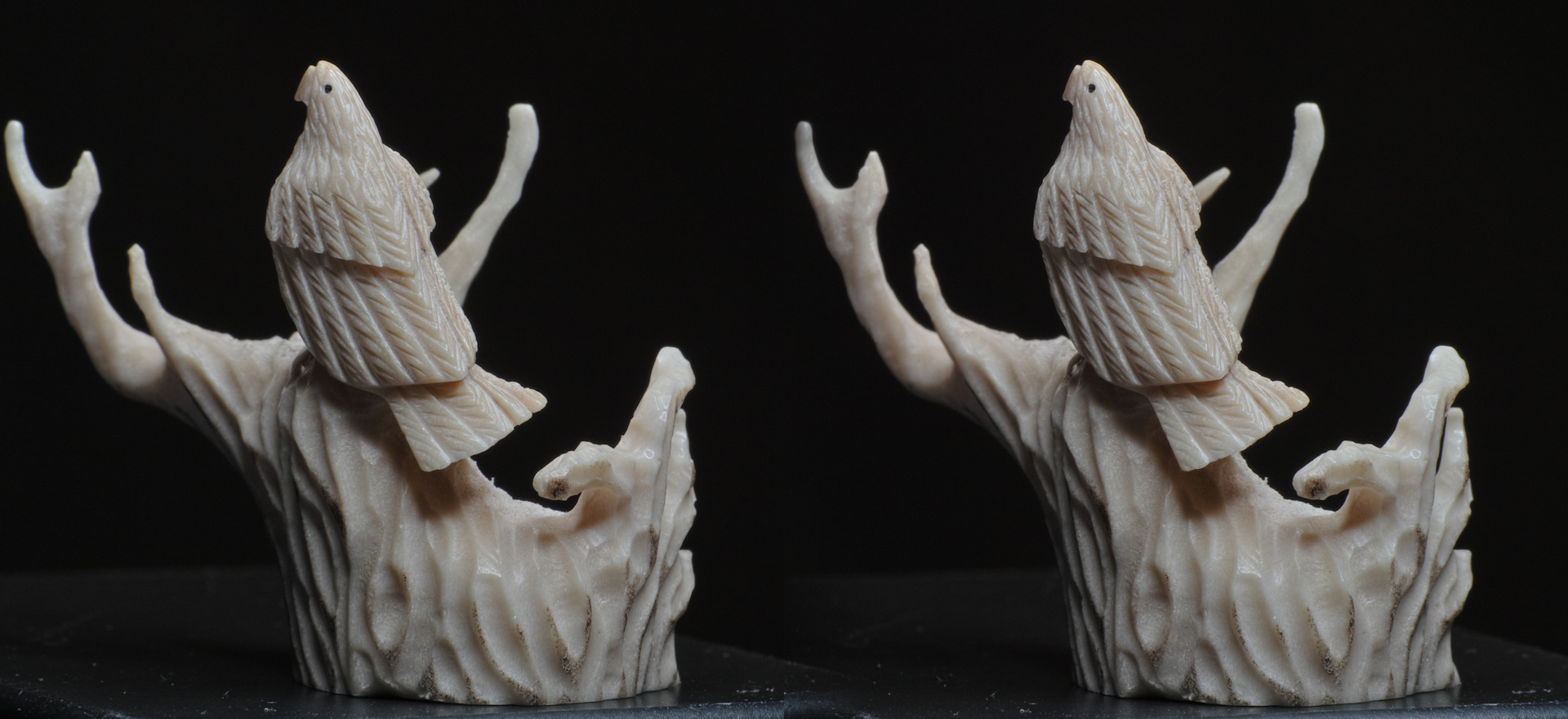
Native American Fetish Carving
This was done using a segmented mirror beam splitter box and a Sigma DP3 Merrill, with a front 3 diopter 72 mm diameter achromat for extra magnification. This little carving is only 1-1/4″ tall. I bought it from a Native American artist in Albuquerque from the State Fair 2006. I am looking for his name, but can’t find the receipt. If I find it I will update the post. This was done with a ring flash held off-camera (up and to the left). with a black velvet background. You can see the plastic base the carving was resting on. The lower left photo is the mirrorbox with the top off. The two first surface mirrors direct the left and right halves of the camera frame along axes that give a 12 mm stereobase. Stereophotomaker corrects the slight keystone distortion nicely. Its made from 1/4″ ABS sheet solvent welded. The lower left face of the cube has a filter mount for screwing on AR filter and accessory lenses, the right face has a filter mount with adapter which accepts the Merrill DP3. Knobs allow the filter ring to be loosened to align the camera with horizontal plane of the macrobox. The macro mirrorbox is essentially treated as a “lens”. It hangs off the Merrill, which has a nice strong snoot. The right image shows the rig in use. The camera is mounted to the Benro Angel tripod with ARCA plate…from this vantage point, the mirrorbox is hidden by the flash power supply at the top. The accessoy lens and ring flash are on the left facing face of the cube. The subject here is a sprig of pinon stuck in an old 120 takeup spool. I’ll convert that image to film. Have some nice macro shots with this rig, just getting used to it.
ALSO: I will look at moving back or using focus stacking to increase DOF so the entire subject is sharp.
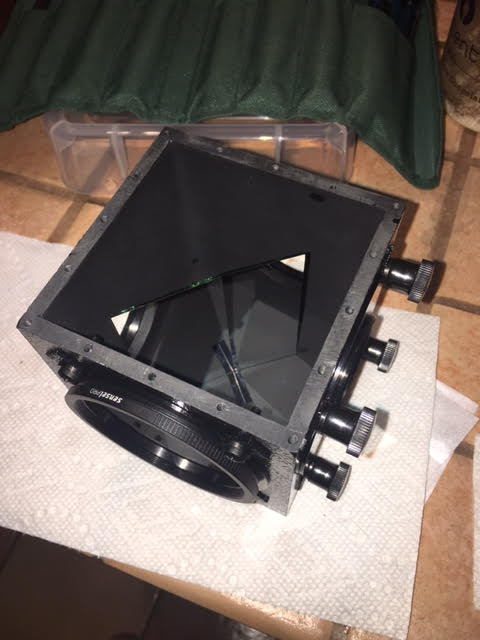
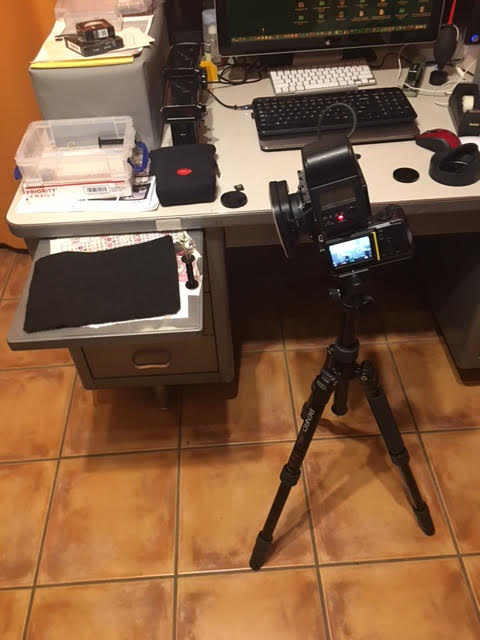
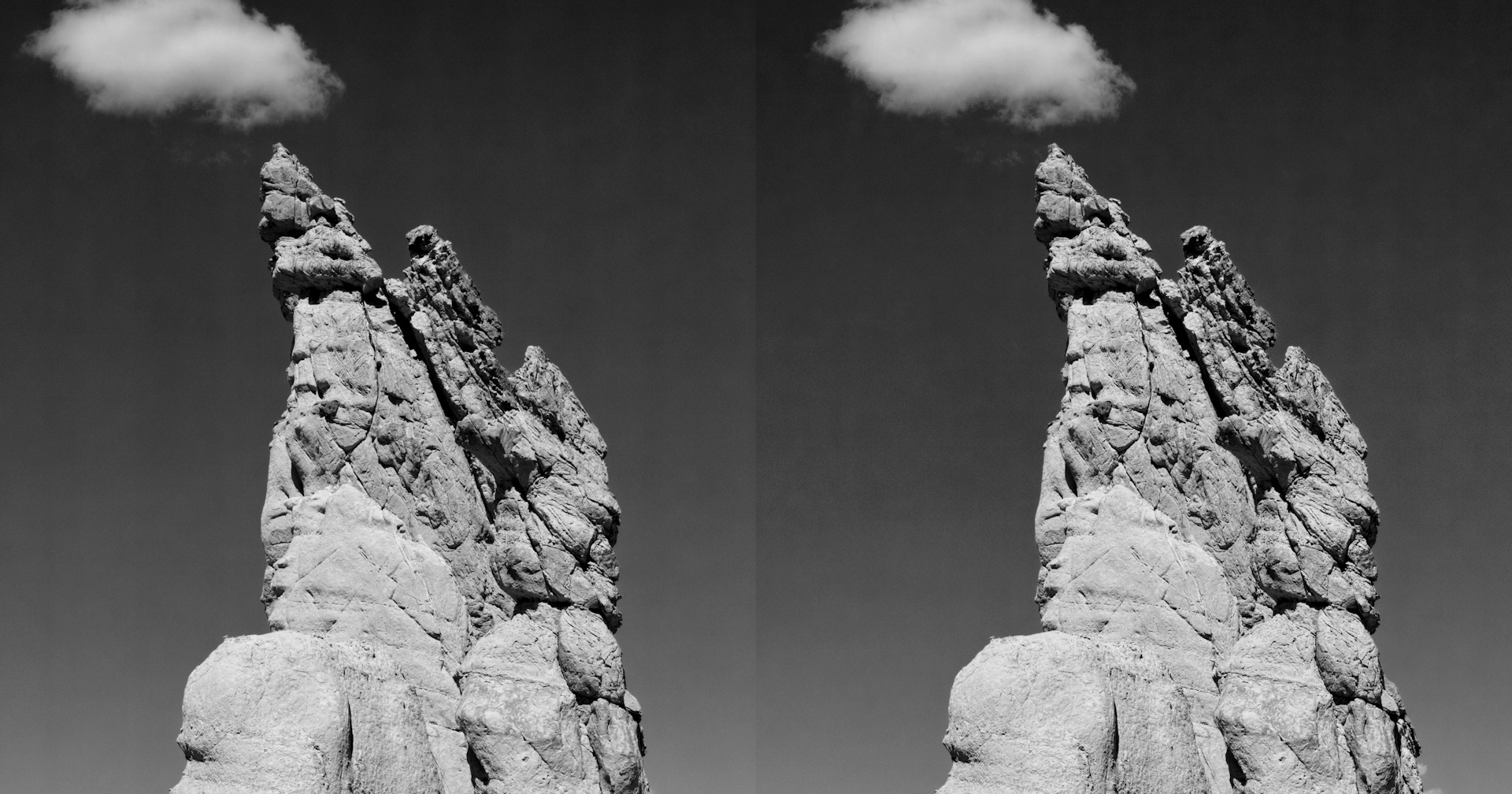
Dragon and Rider, Plaza Blanca
Alternate view of the Dragon Spine formation at Plaza Blanca, about one hour north of Santa Fe New Mexico by car, the last couple of miles is a dirt road. Process used is the same as for the Dragon Spine image (described in more detail there). The process for digital to film I described in my notes for A28 folio entries. This is the red channel only, spreading the histogram to result in maximum range from black to white (some of the streaks are from the JPG compression when I uploaded this image). The 16 bit Sigma Merrill image (which as 12 bits of useful range, padded to 16 bits) was processed in Corel PSP. This seems to introduce some aliasing in dark quarter-tones, next time I’ll use a 16 bit work flow. Most of the PSP workflow is 16 bit, but histogram manipulation seems to sometimes result in gaps in the color scale. This can be seen in the patterns in the sky, which was pushed down to make it dark. I could also try a red filter, but the red layer of the Merrill sensor is pretty good at that color separation. Perhaps a polarizer! Someone showed a film rig in 2012 (the MF SIG) at my first NSA and it had some square gradient filters, I could likely go that route (I think it was Bob Venezia). Close one eye and you could imagine this is a rider and a dragon, with a puff of smoke. In 3D that illusion is less convincing. Still, the figure to the lower right looks like and earnest fellow with a big nose and his muscular arms at his sides.
[ed. Jon provided me these thumbnails, but no accompanying text]
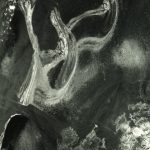 The Mendenhall is magnificent from a distance. It is spectacular if you can get up close and personal.
The Mendenhall is magnificent from a distance. It is spectacular if you can get up close and personal.
The ice has layers and threadsof dirt and sand which were washed down and embedded in the originating snow. As the glacier is pushed down the valley, the face melts away and the embedded dirt, sand, sticks, leaves, and silt are released. You should be suspicious of anyone selling you “crystal clear glacier ice” 🙂
Tripod mounted TL120-1, DR5-processed HP5
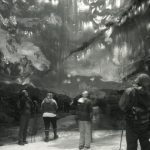 There are often caves in and under the Mendenhall glacier. In the winter, when the lake is frozen and travel is easier, there are often many folks visiting.
There are often caves in and under the Mendenhall glacier. In the winter, when the lake is frozen and travel is easier, there are often many folks visiting.
On this particular day, I set my camera up and loitered in the corner. The first set of bystanders is always very self conscious and makes explicit efforts to stay away and not “spoil” the shot. By simply loitering with a long cable release (while wearing warm clothes), I out-wait them and they are replaced. The newcomers ignore me as part of the landscape. Then I can trip the shutter, and reach over to advance the film.
Tripod mounted TL120-55. DR5-processed HP5
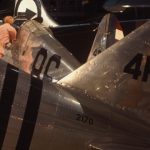 This is an interior, available-light image from the National Museum of the U.S. Air Force in Dayton. All those aluminum surfaces were just begging to be captured in stereo. The farthest tail looks to me like a B29, but I didn’t take notes about the fighters in the foreground. Can anyone identify them for us?
This is an interior, available-light image from the National Museum of the U.S. Air Force in Dayton. All those aluminum surfaces were just begging to be captured in stereo. The farthest tail looks to me like a B29, but I didn’t take notes about the fighters in the foreground. Can anyone identify them for us?
Available light, tripod mounted Canon 7D. Digital to film transfer done by Gamma Tech in New Mexico. Yes, I know I mounted it backwards 🙁
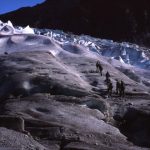 The Mendenhall glacier is in a National Forest, so commercial exploitation is expected and encouraged. One business here hikes you to the ice. There, you don crampons and helmets before setting off on an ice-trek. Four hours earlier, these folks were probably disembarking from their cruise ship. Now they’re on the glacier and about to practice their fall-arrests.
The Mendenhall glacier is in a National Forest, so commercial exploitation is expected and encouraged. One business here hikes you to the ice. There, you don crampons and helmets before setting off on an ice-trek. Four hours earlier, these folks were probably disembarking from their cruise ship. Now they’re on the glacier and about to practice their fall-arrests.
This is a cool place to live.
Tripod mounted TL120-1, most likely done on Provia 100.
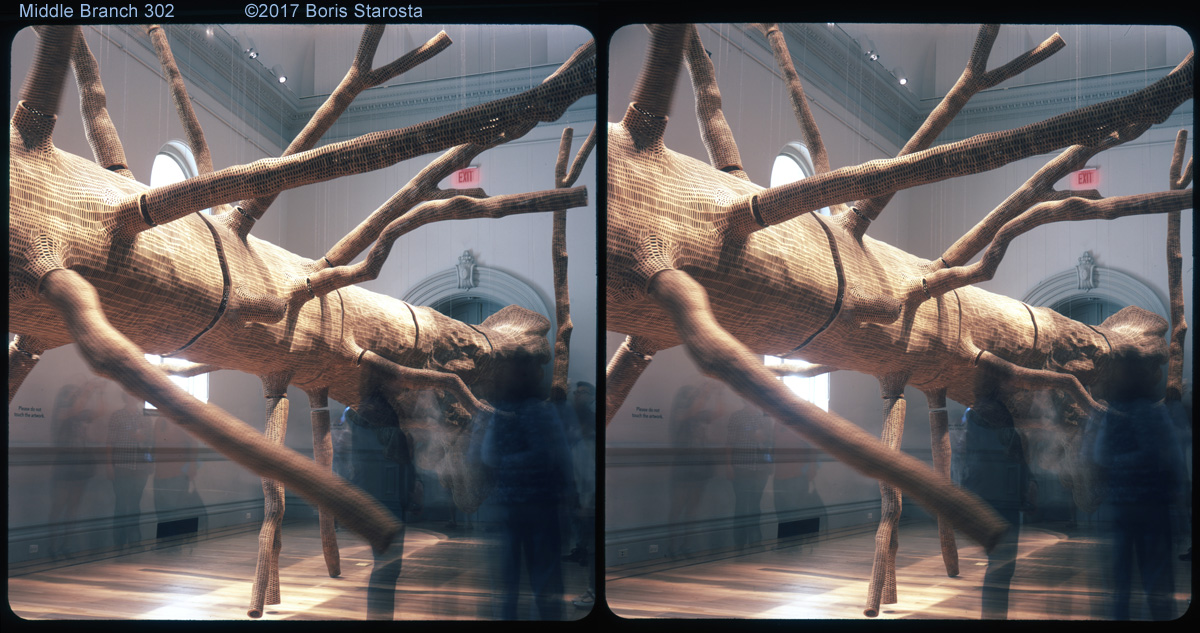
Last year we went to an exhibition of installation artists called “Wonder” at the Renwick Gallery in Washington, DC. Several artists made very interesting pieces for this show. Using hundreds of thousands of pieces of reclaimed, old-growth cedar, John Grade built an intricate structure – Middle Fork – based on plaster casts taken of a massive, old-grown hemlock tree in the Cascade Mountains. At Wonder, I shot cha-cha’s with my Sigma DP1-M and a Sputnik. Tripods were not allowed, but I was incredibly lucky: each room in the Renwick had a fairly broad chair rail along the wall, wide enough to give good support to the Spud. The exposures were typically 15 to 30 seconds.